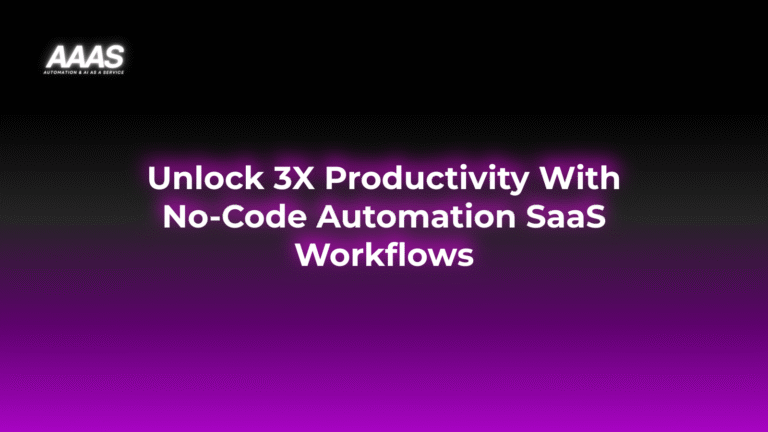Leveraging No-Code Automation and SaaS Integration for Business Workflow Optimization

Market Problem: Inefficiency in Business Workflows
Modern businesses grapple with managing multiple digital tools and manual workflows, leading to:
- Repetitive tasks and data silos
- Human errors caused by manual processing
- High operational costs and resource drain
- Lack of agility and slow time-to-market for new initiatives
Research from McKinsey reveals that companies waste 20-30% of their revenue due to inefficiencies and disconnected tools—a massive obstacle for growth and competitiveness.
Solution: No-Code Automation & SaaS Integration

No-code automation platforms let businesses automate operations and integrate their SaaS tools—without writing code or hiring developers. Leading solutions like Zapier, Make (Integromat), Workato, and Tray.io are revolutionizing digital workflows across industries.
Key Benefits
- Efficiency: Automate repetitive tasks, freeing staff for higher-value work.
- Productivity: Accelerate processes like onboarding, data synchronization, and notifications across apps.
- Cost Reduction: Minimize manual labor and IT development expenses.
- Scalability: Easily adapt automation as your SaaS stack evolves.
- Reliability: Reduce errors typical of manual processes.
Automating multi-app workflows bridges data silos and ensures seamless, real-time information synchronization—driving informed decisions and improved customer experiences.
Real-World Use Cases
1. Lead Management Automation
Automatically sync new leads from web forms (e.g., Typeform, HubSpot) to your CRM (e.g., Salesforce) and send internal Slack notifications, reducing lead response times and manual entry errors.
2. Employee Onboarding
Trigger multi-step onboarding processes by integrating HR platforms (e.g., BambooHR) with IT provisioning tools, email, and project management apps (e.g., Asana) for seamless new hire experiences.
3. Invoice and Payment Workflows
Connect invoicing platforms (e.g., QuickBooks) with payment gateways and bank reconciliation tools to minimize finance team workloads and ensure accuracy.
4. Customer Support Automation
Route tickets from Zendesk to the right support agent and update CRM records automatically, reducing time-to-resolution and improving satisfaction.
Technical Details: How No-Code Automation Works
Architecture & Integrations
- Triggers: Actions/events in one app (e.g., “new email received”)
- Actions: Automated steps in other connected SaaS apps (e.g., “add row to Google Sheet”)
- User Interface: Drag-and-drop workflow builders and template libraries
- APIs & Connectors: Platform pre-built integrations for 1,000+ apps

Platforms often provide version control, error handling, conditional logic, reporting dashboards, and robust security—making enterprise-grade automation accessible without specialized development skills.
Comparison with Traditional Approaches
| Factor | No-Code Automation | Manual/Custom Dev |
|---|---|---|
| Speed of Deployment | Minutes – Days | Weeks – Months |
| Required Skills | Non-technical (drag & drop) | Developers, IT teams, QA |
| Maintenance | Automated updates | Ongoing manual updates |
| Flexibility | Easy to change flows | Often complex to modify |
| Upfront Costs | Usually subscription-based, lower | High development cost |
No-code integration enables rapid scaling, immediate improvement, and accessibility for business users—as opposed to custom code, which is slower, more expensive, and harder to adapt.
Pricing Overview & Considerations
| Platform | Free Plan | Paid Plans | Enterprise |
|---|---|---|---|
| Zapier | ✓ | From $19.99/mo | Custom pricing |
| Make (Integromat) | ✓ | From $9/mo | Custom pricing |
| Workato | ✗ | From $250/mo | Custom pricing |
| Tray.io | ✗ | Contact Sales | Custom pricing |
Most platforms charge per task/run, number of integrations, or active users. ROI typically far exceeds costs due to the operational savings and capacity unlocked.
ROI-Focused Practical Examples
- HR Automation: Automating onboarding for a 100-person company can save over 400 hours/year—valued at $12,000+ in labor costs.
- Sales & Marketing: Automated lead routing and follow-ups have driven a 23% increase in deal-close rates (source: VentureBeat).
- Finance: Accounts Payable automation can reduce invoice processing costs up to 80% (Gartner).
With proper implementation, payback on automation investments is commonly under three months (Forrester, “The Total Economic Impact™ of Automation”).
Step-by-Step Setup Guide
- Map and document existing workflows and pain points.
- Identify repetitive, manual tasks that consume the most time.
- Evaluate top no-code automation platforms for your software stack.
- Sign up and connect your SaaS applications (using secure OAuth/APIs).
- Build a simple automation (e.g., move new CRM leads to a Google Sheet).
- Test workflows with sample data; monitor for accuracy and edge cases.
- Iterate, add complexity (branching, conditions), and roll out to more users/teams.
- Track key metrics (time saved, errors reduced, cost reduction).
Pros and Cons
| Pros | Cons |
|---|---|
|
|
Expert Tips for Successful Adoption
- Start small: Automate one workflow, validate impact, then expand.
- Train end-users: Provide onboarding and documentation to maximize adoption.
- Monitor and iterate: Regularly review automation logs and workflow performance.
- Establish ownership: Assign responsibility for workflow updates and governance.
- Integrate security best practices: Use strong authentication and limit access to sensitive data.
- Continuously explore new automation possibilities: Stay updated on platform capabilities and integrate emerging SaaS tools as needed.
FAQ
- Can non-technical teams set up no-code automation?
- Yes. Most leading platforms are designed for business users with friendly interfaces, pre-built templates, and simple logic tools.
- What types of SaaS apps can I integrate?
- Thousands—ranging from project management (e.g., Trello, Asana), CRM (e.g., Salesforce), marketing (e.g., Mailchimp), HR, accounting, and beyond.
- How secure are no-code automation platforms?
- Major platforms comply with global security standards (SOC2, GDPR, etc.) but always validate that your provider meets your company’s requirements.
- Can no-code automations scale?
- Yes. Most solutions offer robust, enterprise-grade scaling, supporting millions of workflow executions a month.
- How does this compare with RPA (Robotic Process Automation)?
- No-code SaaS integration platforms are focused on cloud APIs and app integrations, while RPA mimics user actions in desktop software. RPA is often more complex to implement and manage.
References & Citations
- McKinsey: Five Myths About No-Code/Low-Code Platforms
- VentureBeat: How No-Code Automation Is Driving Productivity
- Gartner: Insights on Automation
- Forrester: The Total Economic Impact™ of Automation
Last updated: 2025-10-02








